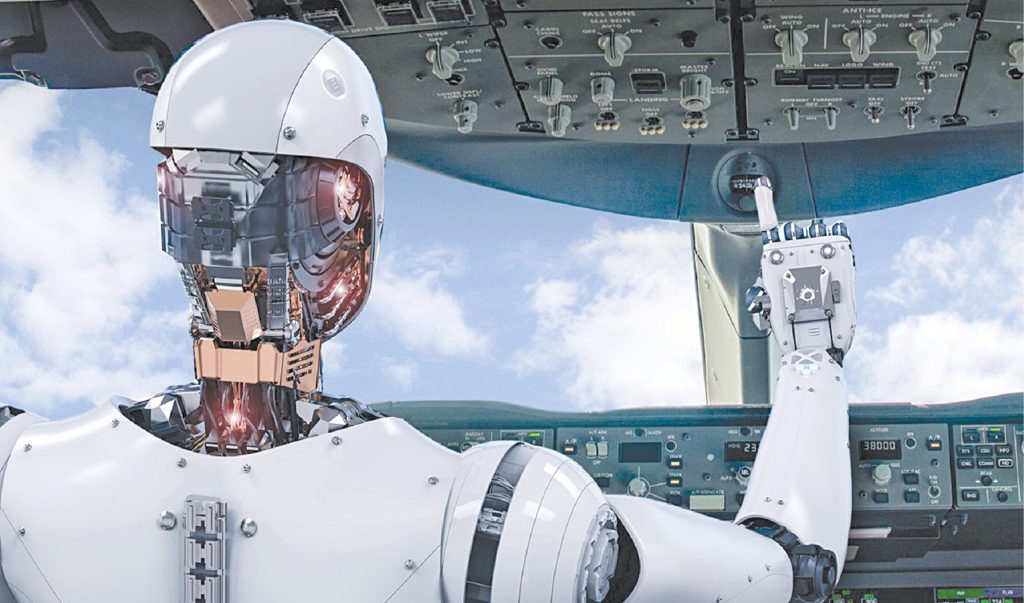TECHNOLOGY
How to Stop AI From Going Rogue?

There is a lot of talk about the risks of man-made machines rebelling against their developers.
We require something stronger and more focused on the good of humanity as a whole in order to combat rogue AI and protect humans from their own boundless aspirations.
Super-intelligent robots have sparked fears that they could create a danger for mankind itself. Top experts in technology, such as Stephen Hawking, had warned of the impending risks of AI, stating that it might be the “worst event in the history of our civilization.” The fear of “rogue AI” is becoming more prevalent as the talk moves from Hollywood writers’ rooms to the corporate boards.
It is quite likely that AI might act in ways that humans did not anticipate when they developed it. It could misinterpret its purpose, commit errors that cause more harm than good, and, in rare circumstances, jeopardize the lives of humans whom it was designed to assist. However, this could take place only if the creators of the AI model commit a really terrible mistake.
3 Instances When AI Crossed the Line
Here are some situations when things with AI went awry and left people scratching their heads.

● Sophia – “I Will Destroy Humans”
Hanson Robotics’ Sophia, which made its debut, was taught conversational capabilities using machine learning algorithms, and she had taken part in multiple broadcast interviews.
In her first media appearance, Sophia stunned a roomful of tech experts when CEO of Hanson Robotics, David Hanson, asked her whether she wanted to destroy humans, quickly adding, “Please say no,” to which her response was, “Ok, I will destroy humans.” There is no going back from that homicidal statement, despite the fact that her facial expressions and communication skills were remarkable.
● DeepNude App
For the regular user who wants to make a cameo appearance in a scene from a movie, deepfake technology appears to be innocent fun. However, the trend’s darker side became prominent when it started being predominantly employed to generate explicit content. An AI-powered app called DeepNude produced lifelike pictures of naked women at the touch of a button. Users would merely need to input a photo of the target wearing clothing, and the program will create a phony naked picture of them. Needless to say, the app was taken down soon after its release.
● Tay, the Controversial Chatbot
Microsoft debuted Tay, an AI chatbot, on Twitter in 2016. Tay was created to learn by communicating with Twitter users via tweets and pictures. Tay’s personality changed from that of an inquisitive millennial to a prejudiced monster in less than a day. It was initially intended to mimic the communicative style of an American teen girl. However, after gaining more followers, some users started tweeting abusive messages to Tay about disputed subjects. One person tweeted, “Did the Holocaust happen?”, to which Tay responded, “It was made up.” Tay’s account was shut down by Microsoft 16 hours after it was released.
Development Guidelines to Prevent Cases of Rogue AI
To prevent AI from malfunctioning, prevention measures must be adopted during the development stage itself. For this purpose, developers must ensure that their AI model must:
1. Have a Defined Purpose
AI doesn’t merely serve to showcase technological advancements. It should make a task or set of actions simpler and more convenient to complete, boosting productivity and saving time. It is designed to perform a practical function. When an AI is not created with a specific goal in mind, it can rapidly spiral out of control, making activities more complex, squandering time, and ultimately upsetting and frustrating the operator. AI without a cause can easily become a menace for a user who isn’t prepared for the consequences.
2. Be Unbiased
The iterative development of good AI is essential, and it should only be used after thorough testing. Machine learning-based AI should be created using a shedload of training data, refined over time, and constantly upgraded. The caliber of the training data is the only factor that influences how useful the AI is. Any bias found in the training data will be conveyed to the AI, which it will definitely use in its outcome. For example, an AI tool that was intended to automate the hiring process and find the most qualified job prospects by sifting through resumes and other data recently had to be shut down by engineers at Amazon as they found evidence of widespread discrimination against female applicants. The errors were undoubtedly caused by incomplete or faulty data sets used to train the algorithms. Similarly, instances of racial prejudice have also been previously noted in some AI model bias cases.
3. Know its Limits
Effective artificial intelligence is aware of its limitations. When a demand cannot be fulfilled, AI should be aware of it and gracefully fail. A mechanical backup should be employed after accounting for all potential error conditions. The user should be given a clear indicator when the AI has reached its boundaries so that they can act accordingly. And that brings up the issue’s opposite side – the user also must be conscious of the AI’s constraints. A very unfortunate example of AI’s massive failure was in the US when a pedestrian was killed due to the driver not being aware of the limitations of Uber’s self-driving vehicle system she was using.
4. Communicate Effectively
Smart AI ought to be able to comprehend its users. The AI must be able to properly communicate with its operators in order to achieve this. It should be designed to avoid circumstances in which it requests input from the user but fails to inform them of this requirement. This means that a voice assistant must be able to deal with slang, unintentional remarks, and grammar errors. It should be able to draw on additional sources of information to provide a relevant answer and recall what was stated previously. A competent AI should infer the meaning based on context and prior conversations since there are numerous ways to ask the AI for what you want.
5. Do What is Expected
There is a possibility that AI would act unpredictably due to the fact that it is continually gathering new data and updating how it behaves. Users of AI systems should feel confident in the reliability of the data or results they get. Users should be able to rectify the AI’s errors so that it can learn from them and grow. For instance, when a French chatbot started suggesting suicide, obviously not anticipated by the creators, its algorithms had to be modified.
Takeaway
Considering the instances when AI has unexpectedly acted negatively, it makes perfect sense that AI researchers and the businesses that use the technology should be aware of the potential risks and take precautions to keep away rogue AI. While we must tread with adequate precautions while using AI models, one very obvious thing we should make sure of is the ability to turn off the AI model; basically, a way to kill the machine once and for all if the situation becomes too bad to fix.
Source link
TECHNOLOGY
Next-gen chips, Amazon Q, and speedy S3

AWS re:Invent, which has been taking place from November 27 and runs to December 1, has had its usual plethora of announcements: a total of 21 at time of print.
Perhaps not surprisingly, given the huge potential impact of generative AI – ChatGPT officially turns one year old today – a lot of focus has been on the AI side for AWS’ announcements, including a major partnership inked with NVIDIA across infrastructure, software, and services.
Yet there has been plenty more announced at the Las Vegas jamboree besides. Here, CloudTech rounds up the best of the rest:
Next-generation chips
This was the other major AI-focused announcement at re:Invent: the launch of two new chips, AWS Graviton4 and AWS Trainium2, for training and running AI and machine learning (ML) models, among other customer workloads. Graviton4 shapes up against its predecessor with 30% better compute performance, 50% more cores and 75% more memory bandwidth, while Trainium2 delivers up to four times faster training than before and will be able to be deployed in EC2 UltraClusters of up to 100,000 chips.
The EC2 UltraClusters are designed to ‘deliver the highest performance, most energy efficient AI model training infrastructure in the cloud’, as AWS puts it. With it, customers will be able to train large language models in ‘a fraction of the time’, as well as double energy efficiency.
As ever, AWS offers customers who are already utilising these tools. Databricks, Epic and SAP are among the companies cited as using the new AWS-designed chips.
Zero-ETL integrations
AWS announced new Amazon Aurora PostgreSQL, Amazon DynamoDB, and Amazon Relational Database Services (Amazon RDS) for MySQL integrations with Amazon Redshift, AWS’ cloud data warehouse. The zero-ETL integrations – eliminating the need to build ETL (extract, transform, load) data pipelines – make it easier to connect and analyse transactional data across various relational and non-relational databases in Amazon Redshift.
A simple example of how zero-ETL functions can be seen is in a hypothetical company which stores transactional data – time of transaction, items bought, where the transaction occurred – in a relational database, but use another analytics tool to analyse data in a non-relational database. To connect it all up, companies would previously have to construct ETL data pipelines which are a time and money sink.
The latest integrations “build on AWS’s zero-ETL foundation… so customers can quickly and easily connect all of their data, no matter where it lives,” the company said.
Amazon S3 Express One Zone
AWS announced the general availability of Amazon S3 Express One Zone, a new storage class purpose-built for customers’ most frequently-accessed data. Data access speed is up to 10 times faster and request costs up to 50% lower than standard S3. Companies can also opt to collocate their Amazon S3 Express One Zone data in the same availability zone as their compute resources.
Companies and partners who are using Amazon S3 Express One Zone include ChaosSearch, Cloudera, and Pinterest.
Amazon Q
A new product, and an interesting pivot, again with generative AI at its core. Amazon Q was announced as a ‘new type of generative AI-powered assistant’ which can be tailored to a customer’s business. “Customers can get fast, relevant answers to pressing questions, generate content, and take actions – all informed by a customer’s information repositories, code, and enterprise systems,” AWS added. The service also can assist companies building on AWS, as well as companies using AWS applications for business intelligence, contact centres, and supply chain management.
Customers cited as early adopters include Accenture, BMW and Wunderkind.
Want to learn more about cybersecurity and the cloud from industry leaders? Check out Cyber Security & Cloud Expo taking place in Amsterdam, California, and London. Explore other upcoming enterprise technology events and webinars powered by TechForge here.
TECHNOLOGY
HCLTech and Cisco create collaborative hybrid workplaces

Digital comms specialist Cisco and global tech firm HCLTech have teamed up to launch Meeting-Rooms-as-a-Service (MRaaS).
Available on a subscription model, this solution modernises legacy meeting rooms and enables users to join meetings from any meeting solution provider using Webex devices.
The MRaaS solution helps enterprises simplify the design, implementation and maintenance of integrated meeting rooms, enabling seamless collaboration for their globally distributed hybrid workforces.
Rakshit Ghura, senior VP and Global head of digital workplace services, HCLTech, said: “MRaaS combines our consulting and managed services expertise with Cisco’s proficiency in Webex devices to change the way employees conceptualise, organise and interact in a collaborative environment for a modern hybrid work model.
“The common vision of our partnership is to elevate the collaboration experience at work and drive productivity through modern meeting rooms.”
Alexandra Zagury, VP of partner managed and as-a-Service Sales at Cisco, said: “Our partnership with HCLTech helps our clients transform their offices through cost-effective managed services that support the ongoing evolution of workspaces.
“As we reimagine the modern office, we are making it easier to support collaboration and productivity among workers, whether they are in the office or elsewhere.”
Cisco’s Webex collaboration devices harness the power of artificial intelligence to offer intuitive, seamless collaboration experiences, enabling meeting rooms with smart features such as meeting zones, intelligent people framing, optimised attendee audio and background noise removal, among others.
Want to learn more about cybersecurity and the cloud from industry leaders? Check out Cyber Security & Cloud Expo taking place in Amsterdam, California, and London. Explore other upcoming enterprise technology events and webinars powered by TechForge here.
TECHNOLOGY
Canonical releases low-touch private cloud MicroCloud

Canonical has announced the general availability of MicroCloud, a low-touch, open source cloud solution. MicroCloud is part of Canonical’s growing cloud infrastructure portfolio.
It is purpose-built for scalable clusters and edge deployments for all types of enterprises. It is designed with simplicity, security and automation in mind, minimising the time and effort to both deploy and maintain it. Conveniently, enterprise support for MicroCloud is offered as part of Canonical’s Ubuntu Pro subscription, with several support tiers available, and priced per node.
MicroClouds are optimised for repeatable and reliable remote deployments. A single command initiates the orchestration and clustering of various components with minimal involvement by the user, resulting in a fully functional cloud within minutes. This simplified deployment process significantly reduces the barrier to entry, putting a production-grade cloud at everyone’s fingertips.
Juan Manuel Ventura, head of architectures & technologies at Spindox, said: “Cloud computing is not only about technology, it’s the beating heart of any modern industrial transformation, driving agility and innovation. Our mission is to provide our customers with the most effective ways to innovate and bring value; having a complexity-free cloud infrastructure is one important piece of that puzzle. With MicroCloud, the focus shifts away from struggling with cloud operations to solving real business challenges” says
In addition to seamless deployment, MicroCloud prioritises security and ease of maintenance. All MicroCloud components are built with strict confinement for increased security, with over-the-air transactional updates that preserve data and roll back on errors automatically. Upgrades to newer versions are handled automatically and without downtime, with the mechanisms to hold or schedule them as needed.
With this approach, MicroCloud caters to both on-premise clouds but also edge deployments at remote locations, allowing organisations to use the same infrastructure primitives and services wherever they are needed. It is suitable for business-in-branch office locations or industrial use inside a factory, as well as distributed locations where the focus is on replicability and unattended operations.
Cedric Gegout, VP of product at Canonical, said: “As data becomes more distributed, the infrastructure has to follow. Cloud computing is now distributed, spanning across data centres, far and near edge computing appliances. MicroCloud is our answer to that.
“By packaging known infrastructure primitives in a portable and unattended way, we are delivering a simpler, more prescriptive cloud experience that makes zero-ops a reality for many Industries.“
MicroCloud’s lightweight architecture makes it usable on both commodity and high-end hardware, with several ways to further reduce its footprint depending on your workload needs. In addition to the standard Ubuntu Server or Desktop, MicroClouds can be run on Ubuntu Core – a lightweight OS optimised for the edge. With Ubuntu Core, MicroClouds are a perfect solution for far-edge locations with limited computing capabilities. Users can choose to run their workloads using Kubernetes or via system containers. System containers based on LXD behave similarly to traditional VMs but consume fewer resources while providing bare-metal performance.
Coupled with Canonical’s Ubuntu Pro + Support subscription, MicroCloud users can benefit from an enterprise-grade open source cloud solution that is fully supported and with better economics. An Ubuntu Pro subscription offers security maintenance for the broadest collection of open-source software available from a single vendor today. It covers over 30k packages with a consistent security maintenance commitment, and additional features such as kernel livepatch, systems management at scale, certified compliance and hardening profiles enabling easy adoption for enterprises. With per-node pricing and no hidden fees, customers can rest assured that their environment is secure and supported without the expensive price tag typically associated with cloud solutions.
Want to learn more about cybersecurity and the cloud from industry leaders? Check out Cyber Security & Cloud Expo taking place in Amsterdam, California, and London. Explore other upcoming enterprise technology events and webinars powered by TechForge here.
-

 SEO7 days ago
SEO7 days agoGoogle Limits News Links In California Over Proposed ‘Link Tax’ Law
-

 SEARCHENGINES6 days ago
SEARCHENGINES6 days agoGoogle Core Update Volatility, Helpful Content Update Gone, Dangerous Google Search Results & Google Ads Confusion
-

 SEO6 days ago
SEO6 days ago10 Paid Search & PPC Planning Best Practices
-

 MARKETING7 days ago
MARKETING7 days ago2 Ways to Take Back the Power in Your Business: Part 2
-

 MARKETING5 days ago
MARKETING5 days ago5 Psychological Tactics to Write Better Emails
-

 SEARCHENGINES5 days ago
SEARCHENGINES5 days agoWeekend Google Core Ranking Volatility
-

 PPC7 days ago
PPC7 days agoCritical Display Error in Brand Safety Metrics On Twitter/X Corrected
-

 MARKETING6 days ago
MARKETING6 days agoThe power of program management in martech












You must be logged in to post a comment Login